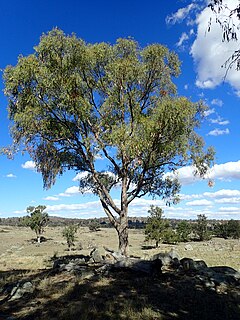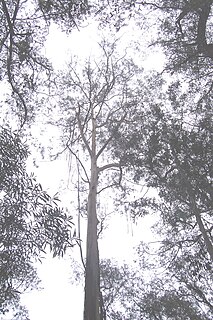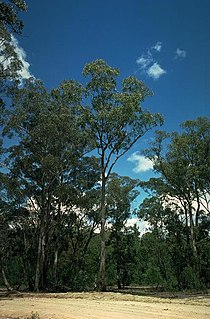
Eucalyptus dives, commonly known as the broad-leaved peppermint or blue peppermint, is a species of tree that is endemic to south-eastern Australia. It has rough, finely fibrous bark on the trunk and larger branches, smooth bark above, lance-shaped or curved adult leaves, flower buds in groups of eleven or more, white flowers and cup-shaped, hemispherical or conical fruit.

Eucalyptus nova-anglica, commonly known as the New England peppermint or black peppermint, is a species of small to medium-sized tree endemic to eastern Australia. It has thick, rough, fibrous bark on the trunk and larger branches, lance-shaped adult leaves, flower buds in groups of seven, white flowers and hemispherical or conical fruit.

Eucalyptus radiata, commonly known as the narrow-leaved peppermint or Forth River peppermint, is a species of tree that is endemic to south-eastern Australia. It has rough, fibrous to flaky bark on the trunk and larger branches, smooth grey bark on the thinner branches, lance-shaped to curved or almost linear leaves, flower buds in groups of eleven to twenty or more, white flowers and cup-shaped, hemispherical or shortenend spherical fruit.

Eucalyptus smithii, commonly known as the gully gum, gully peppermint, blackbutt peppermint, or ironbark peppermint, is a species of medium-sized to tall tree, sometimes a mallee, that is endemic to southeastern Australia. It has rough, compact bark on the trunk, smooth ribbony bark above, narrow lance-shaped adult leaves, flower buds in groups of seven, white flowers and cup-shaped, bell-shaped or hemispherical fruit.

Eucalyptus campanulata, commonly known as the New England blackbutt, gum-topped peppermint or New England ash, is a tree that is endemic to eastern Australia. It has rough, finely fibrous greyish bark on the trunk and larger branches, lance-shaped to curved adult leaves, flower buds arranged in groups of between eleven and fifteen, white flowers and cup-shaped to conical fruit.
Eucalyptus nitida, commonly known as the Smithton peppermint, is a species of tree or mallee that is endemic to Tasmania. It has varying amounts of loose, fibrous or flaky bark, lance-shaped to curved adult leaves, flower buds in groups of nine to fifteen, white flowers and cup-shaped to hemispherical fruit.

Eucalyptus angophoroides, commonly known as the apple-topped box, apple box or apple gum, is a tree endemic to south-eastern Australia. It has rough, flaky or fibrous bark on its trunk and larger branches, lance-shaped adult leaves, white flowers and conical to hemispherical fruit.

Eucalyptus expressa, commonly known as the Wollemi stringybark, is a recently discovered Australian tree species. It has rough, fibrous stringybark on the trunk and larger branches, lance-shaped to curved adult leaves, flower buds in groups of between seven and twenty four and hemispherical to shortened spherical fruit with the valves extending well beyond the rim of the fruit.

Eucalyptus bridgesiana, commonly known as apple box, apple, apple gum or but-but, is a medium to large sized tree. It has rough, fibrous bark on the trunk and larger branches, smooth grey bark above, glossy green, lance-shaped adult leaves, flower buds in groups of seven, white flowers and hemispherical fruit.
Eucalyptus conspicua, commonly known as Gippsland swamp-box, is a species of small tree that is endemic to southeastern Australia. It has rough, thick, fibrous bark from the trunk to its small branches, lance-shaped to curved adult leaves, flower buds in groups of seven, white flowers and conical or hemispherical fruit. The crown of the tree is composed of a dull bluish-green juvenile, intermediate and adult leaves.
Eucalyptus corticosa, also known as Creswick apple-box or Olinda box is a species of small tree that is endemic to a small area in south-eastern New South Wales in Australia. It has rough, fibrous bark on the trunk and branches, dull green, lance-shaped to curved adult leaves, oval flower buds arranged in groups of seven in leaf axils and cup-shaped or hemispherical fruit.
Eucalyptus volcanica is a species of tree that is endemic to northern New South Wales. It has rough, fibrous to flaky bark on the trunk, smooth bark above, lance-shaped or curved adult leaves, flower buds in groups of seven, white or creamy white flowers and cup-shaped or barrel-shaped fruit.
Eucalyptus hypostomatica, commonly known as Pokolbin box, is a species of erect, medium-sized to tall tree that is endemic to New South Wales. It has rough, flaky bark on the trunk and larger branches, lance-shaped adult leaves, flower buds in groups of seven, white flowers and barrel-shaped or conical fruit.
Eucalyptus ignorabilis is a species of small to medium-sized tree that is endemic to southeastern Australia. It has rough, fibrous bark on the trunk and branches, lance-shaped to curved adult leaves, flower buds in groups of seven, white flowers and cup-shaped to hemispherical fruit. It is found in far southeastern New South Wales and eastern Victoria.

Eucalyptus magnificata, commonly known as blue box or northern blue box, is a species of small tree or sometimes a mallee that is restricted to a small area of New South Wales. It has rough, fibrous or flaky bark on the trunk and larger branches, smooth bark above, broadly lance-shaped to egg-shaped leaves, flower buds in groups of seven, white or pale yellow flowers and conical fruit.

Eucalyptus psammitica, commonly known as bastard white mahogany, is a species of small to medium-sized tree that is endemic to eastern Australia. It has rough, stringy or fibrous, prickly bark on the trunk and branches, lance-shaped to curved adult leaves, flower buds in groups of between seven and eleven, white flowers and cup-shaped to hemispherical fruit.
Eucalyptus retinens, commonly known as Hillgrove box, is a species of tree that is endemic to the Northern Tablelands of New South Wales. It has rough, fibrous or flaky bark on the trunk and larger branches, smooth bark on the thinner branches, lance-shaped adult leaves, flower buds in groups of seven, white flowers and cup-shaped, cylindrical or hemispherical fruit.
Eucalyptus costuligera is a species of small tree that is endemic to the Kimberley region of Western Australia. It has short-fibrous or flaky bark on the trunk and branches, bluish, lance-shaped adult leaves, club-shaped flower buds in branched or unbranched inflorescences with the buds in groups of up to seven, creamy-white flowers and conical, cup-shaped or pear-shaped fruit.

Eucalyptus willisii, also known as shining peppermint or promontory peppermint, is a species of small to medium-sized tree, sometimes a mallee that is endemic to Victoria, Australia. It has rough, fibrous bark on the trunk and branches, lance-shaped to curved adult leaves, flower buds in groups of eleven to twenty five, white flowers and cup-shaped or hemispherical fruit.
Eucalyptus arenicola, commonly known as the Holey Plains peppermint or Gippsland Lakes peppermint, is a tree or mallee that is endemic to south-east coastal areas of Victoria. It has rough, fibrous bark on its trunk and branches, glossy green, lance-shaped adult leaves, club-shaped buds arranged in groups of eleven to twenty five, white flowers and cup-shaped to hemispherical fruit.










